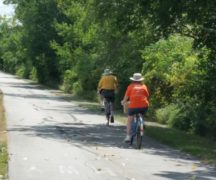By JAN LARSON McLAUGHLIN
BG Independent News
A recent survey of Wood County adults shows that 70 percent are either overweight or obese. Few are eating the recommended servings of fruit and vegetables. And few are drinking the suggested amounts of water.
Ten percent of the adults said in the past year they have had to choose between paying bills and buying food.
The survey also shows many would support more locally grown foods, want more accessible walking and biking trails, and would like local agencies to partner with grocery stores to provide low cost healthy foods.
The 2017 Nutrition and Physical Activity Health Assessment – which is still in its draft form – is intended to help local organizations develop strategies that focus on wellness, access to care, and unmet community needs. The survey is the work of the Wood County Health District and the Hospital Council of Northwest Ohio.
The information was gathered from 456 local residents who completed surveys. A separate section, which came from 106 community leaders in the county, was done to see how close the answers compared between average citizens and key leaders.
The survey showed that key community leaders are much more aware of healthy food options and exercise opportunities in the county.
“One of the biggest gaps we identified was the difference between key leaders and the general public,” said Pat Snyder, communication manager at the Wood County Health District.
“It’s not that every place needs more bike trails or parks, but we need to make people aware” of where they already exist, said Alex Aspacher, county outreach coordinator at the health district.
When completed, the survey will be shared with other local entities interested in the health of Wood County residents.
“We will freely share it with people who want to use it,” Snyder said.
An action plan using the survey results is expected to be created by September.
The partners, the health care leaders of Wood County, have made commitments in order to ensure the success of this effort:
- The assessment will not “sit on a shelf.” The identified priorities and recommendations will be followed up and acted on.
- The assessment will not be done in a vacuum. In order to be successful, any and all stakeholders will need to be involved in current and future efforts. Every agency dealing in some aspect of health care in Wood County needs to be “at the table” and offering their particular areas of expertise and experience. The concept of “health care” is so broad that it cannot be the sole responsibility of any one agency. There can be no “silos” in these efforts or there will be no success.
- The assessment will continue to be repeated on a regular basis and data and results will be trended so that yearly results can be compared. This will ensure that benchmarking can occur and improvements (or degradation) in services noted.
- The assessment will be flexible. As additional unmet needs are identified, or existing needs are met, the study itself must evolve to remain a meaningful and workable instrument for health planning in Wood County.
Key draft findings of the 2017 Health Assessment on adult consumption:
- 70 percent of Wood County adults are either overweight (35%) or obese (35%). This puts them at elevated risk for developing a variety of diseases.
- More than half (67%) of adults were trying to lose weight, 25 percent were trying to maintain their current weight or keep from gaining weight, and 1 percent were trying to gain weight.
- Wood County adults did the following to lose weight or keep from gaining weight: Drank more water (62%), ate less food, fewer calories or foods low in fat (62%), exercised (60%), ate more fruits and vegetables (50%), skipped meals (13%), took diet pills, powders or liquids without a doctor’s advice (3%), went without eating 24 or more hours (2%), smoked cigarettes (1%), and vomited or took laxatives (1%).
- In 2017, 52% of adults ate between 1 to 2 servings of fruits and vegetables per day. 34% ate between 3 to 4 servings and 10% were eating 5 or more servings of fruits and vegetables per day. Less than one-tenth (4%) of Wood County adults did not have any servings of fruits and vegetables. The American Cancer Society recommends that adults eat at least 2 1⁄2 cups (5 servings) of fruits and vegetables per day to reduce the risk of cancer and to maintain good health. In 2013, 42% of Ohio adults consumed fruits less than one time daily and 26% consumed vegetables less than one time daily.
- 10% of adults drank 10 or more servings of water per day, 20% drank between 7 to 9 servings, 33% drank 4 to 6 servings and 35% drank 1 to 3 servings of water per day, while 2% reported they did not consume any water in a day. (The Institute of Medicine, National Academy of Sciences recommends that men drink a total of 16 (cups/servings) and women drink a total of 11 (cups/servings) of total water a day.)
- 14% of adults drank soda pop (not diet), punch, Kool-Aid, sports drinks, energy drinks, or other sugar-sweetened drinks at least once per day in the past week. 43% of adults did not drink any sugar-sweetened beverages in the past week.
- 88% of adults ate out in a restaurant or brought home take-out food at least once in the past week, including 7% of adults who did so for 5 or more meals in the past week.
- Wood County adults reported the following reasons they chose the types of food they ate: Cost (72%), taste/enjoyment (77%), healthiness of food (67%), ease of preparation/time (60%), what their family prefers (51%), availability (44%), food they were used to (41%), nutritional content (37%), calorie content (34%), organic (16%), artificial sweetener content (13%), genetically modified (11%), other food sensitivities (7%), gluten free (4%), health care provider’s advice (6%), lactose free (2%), and other reasons (3%).
Adult Access to Food
- Wood County adults purchased their fruit and vegetables from the following places: large grocery store (97%), farmer’s market (45%), grow their own/garden (39%), local grocery store (26%), mail order food service (3%), Dollar General/Store (2%), community supported agriculture (2%), corner/convenience store (1%), food pantry (1%), mobile produce (1%), community gardens (<1%), and other places (2%).
- Adults reported the following food insecurity issues in consuming fruits and vegetables: too expensive (18%), did not like the taste (8%), did not know how to prepare (7%), no access (2%), no variety (2%), transportation (1%), and other barriers (6%).
- Wood County adults experienced the following food insecurity issues in the past 12 months: had to choose between paying bills and buying food (10%), was worried food would run out (4%), went hungry/ate less to provide more food for their family (4%), loss of income led to food insecurity (4%), they were hungry, but did not eat because they had no money for food (3%) and their food assistance was cut (1%).
Child Consumption (ages 0-5). The following information was reported by Wood County parents of children 0-5 years old.
- 12% of Wood County children ages 0-5 ate 5 or more servings of fruits and vegetables per day. 54% ate 3 to 4 servings per day, 31% ate 1 to 2 servings of fruits and vegetables per day. 4% of parents reported their child did not eat any fruits or vegetables.
- 72% of parents reported their child drank milk, lactose free milk, calcium fortified juice, or other calcium sources at least once per day in the past week. In 2010, The Institute of Medicine, National Academy of Sciences recommends children ages 1 to 3 years consume 700 milligrams of calcium daily.
- 10% of children ages 0-5 drank 5 or more servings of water per day, 42% drank 3 to 4 servings per day, and 40% drank 1 to 2 servings of water per day. 8% of children did not drink any servings of water per day. The Institute of Medicine, National Academy of Sciences recommends that children ages 4-5 years old drink 7 cups/servings of total water per day.
- 8% of Wood County children drank soda pop (not diet), punch, Kool-Aid, juice, or other fruit-flavored drinks at least once per day in the past week. 71% of children did not drink any soda pop or fruit flavored beverages in the past week.
- Mothers breastfed their child: more than 1 year (21%), 10 to 12 months (15%), 7 to 9 months (6%), 4 to 6 months (17%), less than 3 months (17%), still breastfeeding (10%) and never breastfed (10%).
Child Consumption (Ages Pre-K through high school). The following information was reported by Wood County parents of school-age children from Pre-K – high school.
- 5% of Wood County school-age children ate 5 or more servings of fruits and vegetables per day. 43% ate 3 to 4 servings per day, and 50% ate 1 to 2 servings of fruits and vegetables per day. 1% of parents reported their child did not any fruits and vegetables.
- 1% of Wood County school-age children drank 10 or more servings of water per day. 9% drank 7 to 9 servings, 37% drank 4 to 6 servings, and 49% drank 1 to 3 servings of water per day. 1% of children did not drink any water. The Institute of Medicine, National Academy of Science recommends that males ages 9-18 years old drink between 10-14 (cups/servings) and females ages 9-18 years old drink between 9-10 (cups/servings) of total water per day.
- 69% of parents reported their school-age child drank milk, lactose free milk, calcium fortified juice, or other calcium sources at least once per day in the past week.
- 11% of Wood County school-age children drank soda pop (not diet), punch, Kool-Aid, juice, sports drinks, energy drinks or other fruit-flavored drinks at least once per day in the past week. 37% of children did not drink any soda pop or fruit flavored beverages in the past week.
Healthy School Environment. The following information was reported by Wood County parents of school age children from Pre-K – high school.
- Wood County parents reported their child’s school participated in the following fundraising sales: cookie dough (33%), pizza kits (27%), magazines (24%), candy bars (19%), discount cards (16%), popcorn (10%), doughnuts (1%), jewelry (1%), and other (11%).
- Wood County parents reported their child’s school promotes nutrition and physical activity through the following ways: physical education (72%), safe playground equipment (55%), promote bringing water bottles to school (51%), healthy cafeteria food choices (35%), healthy eating habits education (28%), after-school program (24%), salad bar in the cafeteria (14%), safe routes to school (13%), allow breakfast in the classroom (11%), school garden (11%), backpack program (6%), summer food program (2%), and farm-to-school program (1%). 4% of parents reported their child’s school did not have a cafeteria.
- Wood County parents would support the following community improvement initiatives for their schools: increased physical education/recess time (68%), farm-to-school program (58%), more nutrition education in the classroom (55%), healthier fundraising sales (44%), healthier vending machine items (44%), more playground equipment (39%), after-school program (34%), and safe routes to school program (28%).
Adult Physical Activity
- In Wood County, 61% of adults engaged in some type of physical activity or exercise for at least 30 minutes 3 or more days per week. More than one-quarter (28%) of adults exercised on 5 or more days per week. One-tenth (10%) of adults did not participating in any physical activity in the past week, including 2% who were unable to exercise.
- Wood County adults spent the most time doing the following physical activities in the past year: walking (45%), running/jogging (10%), exercise machines (9%), group exercise classes (5%), exercise videos (5%), strength training (5%), occupational exercise (3%), cycling (2%), swimming (2%), active video games (<1%), and other activities (9%). 3% of adults did not exercise at all, including 1% who were unable to do so.
- Reasons for not exercising included: time (47%), too tired (31%), weather (28%), laziness (26%), pain or discomfort (14%), could not afford a gym membership (13%), no child care (9%), no exercise partner (9%), did not know what activities to do (4%), no gym available (3%), physical impairments or challenges (2%), no walking, biking trails or parks (2%), poorly maintained/no sidewalks (1%), doctor advised them not to exercise (1%), and no transportation (<1%).
- Wood County adults spent an average of 2.0 hours watching TV, 1.5 hours on their cell phone, 1.3 hours on the computer (outside of work), and 1.1 hours playing video games on an average day of the week.
Child Physical Activity (Ages 0-5). The following information was reported by Wood County parents of children 0-5 year olds.
- Wood County children ages 0-5 spent an average of 1.4 hours watching TV, 1.0 hour on the computer/tablet/cellphone and 1.0 hours playing video games on an average day of the week.
Child Physical Activity (Ages Pre-K through high school). The following information was reported by Wood County parents of schoolage children from Pre-K – high school.
- 76% of parents reported their child was physically active for at least 60 minutes on 3 or more days per week, 42% reported their child had done so on 5 or more days and 12% said their child was physically active for at least 60 minutes every day per week. 4% reported no physical activity.
- Wood County school-age children spent an average of 1.9 hours on the cell phone, 1.6 hours watching TV, 1.4 hours playing video games and 1.3 hours on the computer (outside of school) on an average day of the week.
- Nearly one-fifth (16%) of Wood County school-age children spent 3 or more hours watching TV on an average day.
Community Characteristics
- Wood County adults reported they lived within 2 miles of the following: a park or green space (77%), grocery stores (57%) and recreation centers (46%).
- 94% of adults reported their community was extremely or quite safe from crime. 5% said slightly safe. No one reported their neighborhood was not safe at all.
- Wood County adults had the following concerns for their community: drugs/alcohol (18%), heavy traffic (16%), no sidewalks accessible (14%), water quality (9%), loud noises (9%), crime (7%), bullying (5%), no place for kids to play (4%), air pollution (3%), lead issues (1%), and other (5%).
Roadways
- 36% of Wood County adults did not have sidewalks where they lived. Of those adults who did not have sidewalks, 22% lived in town, 20% lived in the outskirts of town, and 57% lived in the country.
- Of those adults who had sidewalks, only 32% were connected to all streets. 54% were mostly connected, 12% had some that were connected, 2% had few streets that were connected.
- Of those adults who had sidewalks, 12% were in excellent condition, 66% were in good condition, 12% were in poor condition, 9% were in fair condition and 1% did not know what condition their sidewalks were in.
- 37% of Wood County adults did not have bike trails in or around their community. Of those adults who did not have bike trails, 38% lived in town, 31% lived in the outskirts of town, and 31% lived in the country.
Parks
- 7% of Wood County adults did not have any parks available in or around their community. Of those adults who did not have parks, 6% lived in town, 12% lived in the outskirts of town, and 82% lived in the country.
- Of those adults who had parks available in or around their community, 63% reported there were 3 or more available. 23% had two parks available and 14% had one park available.
- Of those adults who had parks in or around their community, only 52% were handicapped accessible. 42% of adults did not know if their parks were handicapped accessible.
- Of those adults who had parks in or around their community, 26% thought their parks were very safe. 66% reported their parks were quite safe, 1% said slightly safe, and <1% said not safe at all. 6% did know how safe their parks were.
- Of those who had parks in or around their community, 15% of Wood County adults visited them very often, 37% visited them somewhat often, 41% not so often and 7% did not visit them at all.
Other Recreation Areas
- 21% of Wood County adults did not have recreation centers in or around their community. Of those adults who did not have recreation centers, 41% lived in town, 21% lived in the outskirts of town, and 38% lived in the country.
- Of those adults who had recreation centers in or around their community, 12% visited them very often. 16% said somewhat often, 26% said not so often and 46% did not visit them at all. 7% did not know how many recreation centers were available.
Worksite Wellness
- Wood County adults had access to the following programs through their employer or spouse’s employer: health risk assessment (40%), free/discounted gym membership (33%), lower insurance premiums for participating in a wellness program (31%), free/discounted smoking cessation program (22%), free/discounted weight loss program (18%), gift cards for participating in wellness program (15%), on-site health screenings (14%), lower insurance premiums for change in health status (11%), on-site health education classes (7%), gift cards/cash for positive changes in health status (5%), healthier food options in vending machines or cafeteria (4%), and other (5%). 17% did not have access to any wellness program.
- Wood County adult employers promoted work-site wellness through the following: encourage walking during breaks (21%), offer sugar-free beverages (12%), provide healthy food choices in the cafeteria (8%), provide healthy food options in vending machines (7%), and 11% did not know. 54% of Wood County adults employers did not do any of these to promote work-site wellness.
Food Retail Environment
- When asked what type of grocery stores were available in their community Wood County adults reported the following: large grocery chains (83%), convenience stores (85%), Farmer’s Markets (66%), and locally-owned food stores (52%).
- When asked what type of restaurants were available in their community, Wood County adults reported the following: local diners (87%), fast-food restaurants (83%), dine-in/family style restaurants (77%), bakery/café shops (76%), and food trucks (18%).
Community Wellness
- Wood County adults reported that faith-based organizations in their community offered the following: food pantries (68%), community meals (49%), youth sports programs (33%), indoor/outdoor playgrounds (19%), wellness support groups/programs (13%), health screenings (9%), free walking/gym time (5%), nutrition/physical activity education programs (4%), and cooking demonstrations (3%).
- Wood County adults reported that their local hospital(s) and health center(s) offered the following services: health risk assessments (39%), nutrition counseling (37%), weight loss and weight management counseling (36%), health plan incentives for participating in a wellness program (9%), and fitness facility (7%).
- Wood County adults reported their local school districts offered the following at their schools: an outdoor playground accessible to the public (32%), an outdoor/indoor track accessible to the public (28%), school garden (6%), food pantries (4%), health screenings (2%), and health cooking demonstrations (1%). No one reported their local schools offered produce markets.





